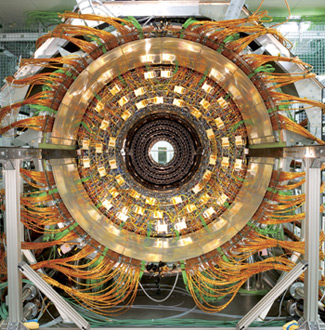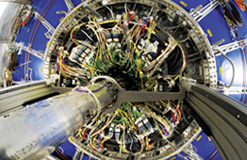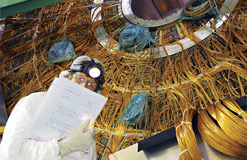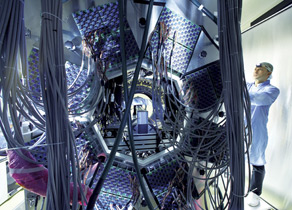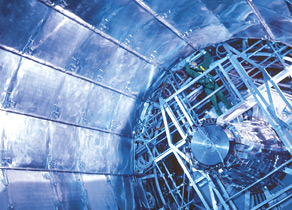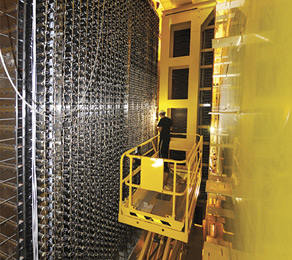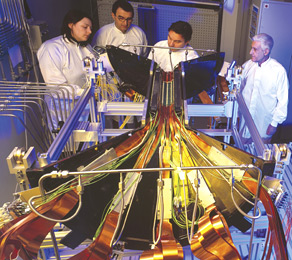Gallery: LHC cabling
It’s heavy, dusty, dirty work: Deep in the bowels of the LHC detectors, workers are rushing to connect a rat’s nest of cables.
By Glennda Chui
If detectors are the eyes and ears of particle physics— sensory organs that pick up the faint echoes of particles colliding—cables are the nerves, the veins, and the digestive tract that connect these organs with their electronic brain and feed them electricity.
And nowhere is there such a grand display of cabling as at the Large Hadron Collider, the world’s most powerful particle accelerator.
If all you did was goggle in awe at the colorful spaghetti that sprouts from the machine’s two big detectors, you’d be missing most of the fun. Out of sight, beneath the floor, are multiple levels of trays, racks, and towers given over almost entirely to cables, along with the pipes that carry water and air and various gases. The official name for this rat’s nest is the labyrinth; but those who know it best jokingly call it a nightmare.
“That’s where the heart of cabling lies,” says Archana Sharma, a CERN physicist who is part of the technical coordination team for the Compact Muon Solenoid detector, or CMS. “The amount of cable and services we are laying down is on the order of supplying a small town of 10,000 inhabitants. People work there day and night to get this task out of the way. Of course, there are a lot of conflicts; sometimes we find things don’t match. You build a house, and you know the sorts of problems we have.”
CMS alone contains 22,780 separate cables, many of them with multiple strands, that put end-to-end would stretch 725 kilometers, or 450 miles—roughly the distance from Brussels to Geneva or Chicago to Pittsburgh.
Laying and connecting all that CMS cable requires 38 people working full-time, plus two special engineers who route the cable, prepare work assignments, and write the database that keeps track of it all. The lab brought in teams of expert cablers—people who honed their skills in factories and power plants—from Russia, Bulgaria, and China.
Even so, a lot of cabling falls to experimenters and their students.
“You can’t really outsource it, because you have to keep track of everything and where it goes. It requires a lot of patience,” says physicist Pamela Klabbers of the University of Wisconsin, Madison, who figures that she and graduate student Jessica Leonard have installed about 1500 cables on their piece of CMS. “It’s heavy work and it’s dirty work. Some of the cables have eight copper wires, and then on top of it each pair is wrapped with metal, and then there’s metal mesh, and then more metal on top of this, and they’re heavy and they’re stiff and you have to push them into place.”
What’s more, with cabling going on at a rapid clip, the guts of both detectors are pretty much packed, making it increasingly difficult to squeeze in there to work—especially while wearing a hard hat with headlamp, sturdy safety boots, and layers of clothes to keep you warm in the chill.
“You really have to be a gymnast to get around. It’s very tight,” says Monica Dunford, an Enrico Fermi Fellow from the University of Chicago who works on the ATLAS experiment. With all the dust that’s accumulated during construction, she adds, she sometimes crawls out looking like a human dust ball.
ATLAS has so little wiggle room that the crew built a model cross-section of the detector about 15 feet high so they could figure out how to fit signal cables, cooling pipes and all the rest. But fit is not the only consideration: For reasons of weight and fragility, access and maximum efficiency, the cables have to be laid in exactly the right order.
“Organization is very important,” says Martin Wensveen, a CERN electro-mechanical engineer who is, as Sharma puts it, the cabling master. “Where do you start? Where do you end? Our philosophy was to always start with the big, heavy cables and then go to the smaller, more delicate ones, and the fiber optics at the end,” because they’re fragile and will crack if bent too far.
Crosstalk is also a problem. With cables packed so close together, electronic signals from one cable can penetrate the next. “So you have to do all sorts of tests,” says Dunford. “We have to make sure there’s no communication between them.”
Cables arrive at the detectors on big, heavy spools—thick, white cables for the control system, red for high voltage, light blue to carry signals from the control center to the detector and back. Each cable’s route is unique, and it’s a full-time job just to calculate how long each one should be. Workers slap a bar code on each cut-to-order cable so it can be entered into a database. Should problems develop, as they inevitably will, this will make it possible, although by no means easy, to trace the offending cable back through the rat’s nest.
Monica Dunford and Pamela Klabbers blog about their experiences at www.uslhc.us. Archana Sharma writes a weekly column, Point 5 News, for the CMS Times.
Click here to download the pdf version of this article.



